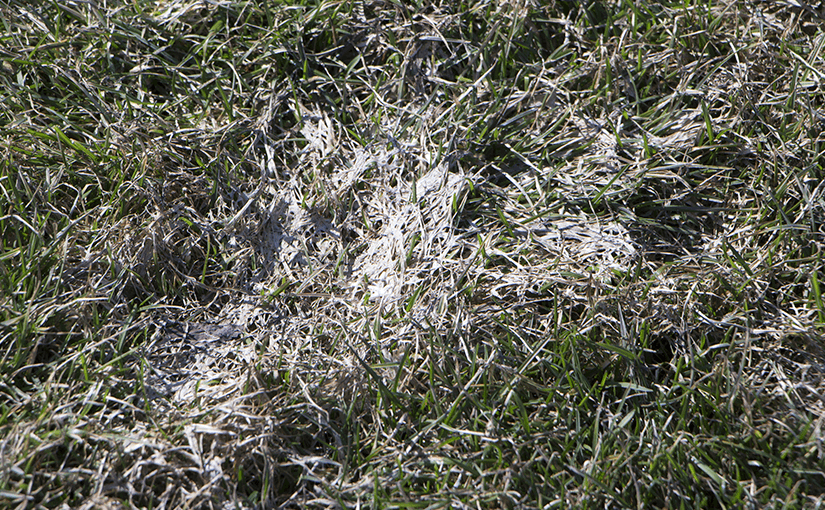When the snow melts and the lawn grass peeks through in the spring, you may notice dark, wet, circular spots in your yard.
It’s snow mold. There are many different kinds of snow mold. Gray snow mold is the typical fungus affecting residential lawns, and primarily with cool season grasses.
What Causes Snow Mold?
Snow mold is a fungus that overwinters in thatch, grass clippings, and crowns of turfgrass.
In the early spring, when the snow melts, you will notice crusty, white—sometimes bleached-looking circles on your lawn. The crusty center is mycelium, and the fungal bodies that are the size of pinheads are sclerotia.
Gray snow mold thrives under cover of snow where the ground isn’t frozen but is still wet. It also flourishes under heavy snow piles and drifts along driveways, walkways, and slopes.
Here are some of the cultural reasons for snow mold to develop on your yard:
- You applied too much fertilizer in late fall. If you used a high nitrogen fertilizer in the fall, you also fed the fungus to develop and multiply.
- Your yard has poor drainage where water doesn’t fully absorb into the soil.
- Your turfgrass wasn’t mowed just before the first freeze. Longer grass bends over itself causing mold to develop.
- Your lawn grass has too much thatch or leaf pile-up.
- Your lawn has soil compaction from heavy use of snowmobiles, skis and pets playing in the yard.
Read how Brinly-Hardy spreaders help you get ice off your driveway and sidewalks.
How to Get Rid of Snow Mold
You have a lot of control when it comes to ridding your lawn of snow mold. Here are some tips on how to get rid of snow mold if you’re hit with it this spring:
- Try to remove heavy snow off your lawn.
- Improve yard drainage.
- Gently rake the infected areas until you remove the mycelium.
- Keep mowing your lawn.
- Only use light fertilizer to encourage healthy turf growth.
- Reseed the infected areas if the lawn grass doesn’t grow back.
Learn what Brinly-Hardy equipment you need to have a beautiful lawn this year.
How to Protect Your Lawn from Snow Molds
While there are a few ways to help get rid of snow molds after they surface on your yard, preventive measures are your best bet. In most cases, you can prevent snow molds from growing on your lawn throughout the winter. Snow mold occurs due to cultural habits and poor yard drainage.
Here are some tips to help you protect your lawn from snow mold next year:
- Use a fall fertilizer that has less nitrogen and more potassium. Potassium helps harden off your lawn grass and protect it from mold. Nitrogen feeds snow mold.
- Make sure you mow your lawn until it stops growing in late fall. When you allow your turfgrass to get too tall, it bends over under heavy snow cover encouraging mold growth.
- In the fall, make sure you aerate your lawn as well as dethatch it. Aeration relieves soil compaction and dethatching it reduces the risk of disease the following winter.
- Don’t let dead leaves pile up. A heavy blanket of leaves is the ideal place for snow mold to grow– make sure you get those leaves off the ground or mulch them back into your yard.
- Make sure there is no snowmobiling or skiing on your lawn next winter.
- Put up snow fences, wind barriers or other methods of blocking snow from drifting on your yard.
- Fix yard drainage, so water percolates through the soil instead of ponding on top of it.
- If your soil is acidic (you can find out with a soil test), apply lime to “sweeten” it. Snow mold loves acidic soil.
- Apply a preventive fungicide. Most snow mold will disappear with the above tips. If Snow Mold has become a consistent problem, consider applying a preventive fungicide in the fall before the first significant snowfall. If you buy fungicides to get rid of snow mold, make sure you follow all of the instructions on the package.
Learn more: Icemaster: 2-Step Snow and Ice Removal.
Brinly-Hardy Lawn Equipment Helps You Prevent Snow Mold from Developing on Your Property
At Brinly-Hardy, we have the lawn care tools to help you maintain a healthy lawn. Here are lawn care and garden equipment you can use to prevent snow mold from forming on your lawn:
You can find Brinly-Hardy lawn care equipment at the following retail outlets:
If you have questions about Brinly-Hardy lawn equipment, call our customer service at 877-728-8224, Monday through Thursday from 8 a.m. to 6 p.m. ET or on Friday from 8 a.m. to 5 p.m. ET. You can also fill out our
contact form, and someone will get back to you.
Sources:
Penn State University – Plant Sciences, “
Gray Snow Mold.”
University of Massachusetts Extension – Turf Program, “
The Snow Molds.”


